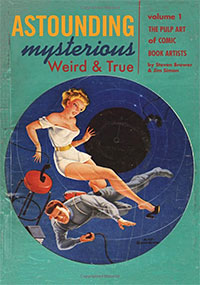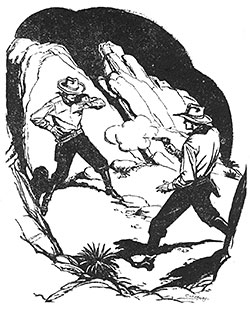 Earlier this year, Steven Brower and Jim Simon published “Astounding, Mysterious, Weird & True, Vol. 1: The Pulp Art of Comic Book Artists,” a book that has an intriguing title. (I’m a sucker for books about the creators of the pulp magazines.)
Earlier this year, Steven Brower and Jim Simon published “Astounding, Mysterious, Weird & True, Vol. 1: The Pulp Art of Comic Book Artists,” a book that has an intriguing title. (I’m a sucker for books about the creators of the pulp magazines.)
This was a book that had great potential, but I’m only moderately pleased with it.
Simon has a nice essay, “Diamonds and Rust,” that opens the book. It includes a brief overview of the pulp magazines (for those who aren’t familiar with them).
Since a number of the pulp publishers also went on to publish comic books, it’s not surprising that some pulp illustrators soon found themselves working in comic books.
It’s fun to flip through the book, admiring the varied styles of illustrations that artists created for the pulps. Since pulp stories typically had only one or two illustrations accompanying them, action figures prominently in many of the examples.
Some of the illustrators’ names are familiar to comic book fans (C.C. Beck, Dick Giordano, Jack Kirby, Joe Simon, Wally Wood) and others will be known by pulp fans (J.C. Burroughs, Edd Cartier, Kelly Freas, Virgil Finlay, Paul Orban). In all, 69 artists are featured in the book’s 183 pages.
The authors let the reader down by providing only the basic information on the artists. Much more detail can easily be found online, at Wikipedia.org for instance. Most artists earn only a paragraph detailing their birth and death years, mentions of where their work appeared, and maybe a few tidbits about them.
For some artists, the book reproduces only one or two examples of their pulp work. Others (usually the more familiar names of pulp artists whose work hasn’t been overlooked) earn five or six examples.
And it’s uncertain if the illustrations shown are the only instances of an artist’s work that appeared in the pulp magazines, or whether that artist was a regular contributor.

Also, I do question whether some of the artwork actually appeared in the pulps.
For instance, take Alex Raymond, who produced the wonderfully illustrated “Flash Gordon,” “Secret Agent X-9” and “Rip Kirby” comic strips. He’s represented by two nicely painted pieces that clearly wouldn’t have reproduced in the roughshod printing and paper used in the pulps. In fact, one of the Raymond illustrations ran in The Elk’s Magazine (a publication by the Elks club) and the other appeared in Collier’s (a slick). So, did Raymond ever work for the pulps? No specific pulp is mentioned in his brief bio.
To be honest, it looks as if the book was quickly put together. The interior design looks like something from an amateur fanzine. That’s surprising when you consider the background of one of the authors: Brower was creative director for the graphic design magazine Print and a former art director at the New York Times. The limited artist information mentioned earlier reflects badly on the other author, Simon, whose background includes novels, comics, and books and essays on comic history.
(I won’t go into the — ahem — “illustrations” of the authors that run next to their bios in the book.)
If you buy “Astounding, Mysterious, Weird & True” to enjoy browsing through the illustrations, you won’t be disappointed; especially for its $12.95 retail price. But don’t go in expecting to learn much new about some of your favorite artists.

